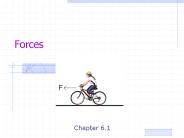Forces - PowerPoint PPT Presentation
1 / 22
Title:
Forces
Description:
... to attract that electron) then they share the electron UNEQUALLY. Depending on how unequally the electrons are shared the bond can have different ... – PowerPoint PPT presentation
Number of Views:37
Avg rating:3.0/5.0
Title: Forces
1
Forces Polarity
2
Bond Polarity
- If two atoms that share electrons have different
electronegativities (ability to attract that
electron) then they share the electron UNEQUALLY. - Depending on how unequally the electrons are
shared the bond can have different
classifications.
3
Bond Polarity and Electronegativity
- If the difference in electronegativities is
greater than 1.7 then the electron is NOT shared
it is completely transferred and the bond is
IONIC.
4
Bond Polarity and Electronegativity
- If the difference in electronegativities is less
than 1.7 then the electron is shared but not
equally and the bond is POLAR COVALENT.
5
Bond Polarity and Electronegativity
- If the difference in electronegativities is zero
then the electron is shared equally and bond is
NON-POLAR COVALENT.
6
Bond Polarity and Electronegativity
7
Examples
NaCl ? Na0.9, Cl3.0 3.0-0.92.1 gt 1.7 ? IONIC
8
Examples
SiBr ? Si1.8, Br2.8 ? 2.8-1.81.0 lt 1.7 ?
Polar Covalent
9
Examples
Se2 ? Se2.4, Se2.4 ? 2.4-2.40 ? Non-Polar
Covalent
10
Molecular Forces Polarity
11
Molecular Forces
- Intramolecular forces are the forces that keep
the atoms in a compound stuck to each other - in
other words, they're just chemical bonds. - H2O H to O
- NaCl Na to Cl
12
Molecular Forces
- Intermolecular forces, on the other hand, are the
forces that hold two covalent molecules to one
another. - H2O to H2O
- These aren't chemical bonds - they're all based
on attractions between different molecules.
13
Intermolecular Forces
- There are three main types of intermolecular
forces. - 1) hydrogen bonds
- 2) dipole-dipole forces
- 3) London dispersion(van der Waals)
14
Hydrogen Bonds
- Hydrogen Bonds are the strongest intermolecular
force. - They are not really a bond
- They are an attraction between a N, O, or F of
one molecule and the hydrogen of another molecule.
15
Dipole-Dipole Forces
- A dipole is when one substance has a positive and
negative end. (Like a magnet) - Dipole-dipole forces take place when the positive
side of one molecule is attracted to the negative
side of another.
16
Dipole-Dipole Forces
- A substance that has dipole-dipole forces is a
POLAR substance - All substances that have hydrogen bonding also
have dipole-dipole forces. - Dipole-dipole are the 2nd strongest
intermolecular force.
17
London Dispersion/van der Waals
- The weakest intermolecular force is the London
dispersion/van der Waals force. - This is a force that occurs between non-polar
molecules. - It happens in ALL molecules when electrons in a
bond are attracted to the nucleus of an atom in
another molecule.
18
How to Determine Intermolecular Forces in a
Molecule?
- STEP 1 DRAW THE LEWIS STRUCTURE
- STEP 2 Look for H bonded to N, O, or F
- If it has it, it has all 3 types of
forces - STEP 3 Look to see if there is a lone pair or
different atoms bonded around the outside of
the structure - If you find them then it has
dipole-dipole and LD/vdW - STEP 4 If none of the above then only has
LD/vdW
19
DRAW THE LEWIS STRUCTURE
Is there an H-N, H-O, or H-F
Yes HB, D-D, LD/vdW
No, Is there a Lone Pair
No, Are all outside atoms the same?
Yes D-D LD/vdW
No D-D LD/vdW
Yes LD/vdW
EX. H2O
20
DRAW THE LEWIS STRUCTURE
Is there an H-N, H-O, or H-F
Yes HB, D-D, LD/vdW
No, Is there a Lone Pair
No, Are all outside atoms the same?
Yes D-D LD/vdW
No D-D LD/vdW
Yes LD/vdW
EX. SiO2
21
DRAW THE LEWIS STRUCTURE
Is there an H-N, H-O, or H-F
Yes HB, D-D, LD/vdW
No, Is there a Lone Pair
No, Are all outside atoms the same?
Yes D-D LD/vdW
No D-D LD/vdW
Yes LD/vdW
EX. HPO
22
DRAW THE LEWIS STRUCTURE
Is there an H-N, H-O, or H-F
Yes HB, D-D, LD/vdW
No, Is there a Lone Pair
No, Are all outside atoms the same?
Yes D-D LD/vdW
No D-D LD/vdW
Yes LD/vdW
EX. SiFCl3































